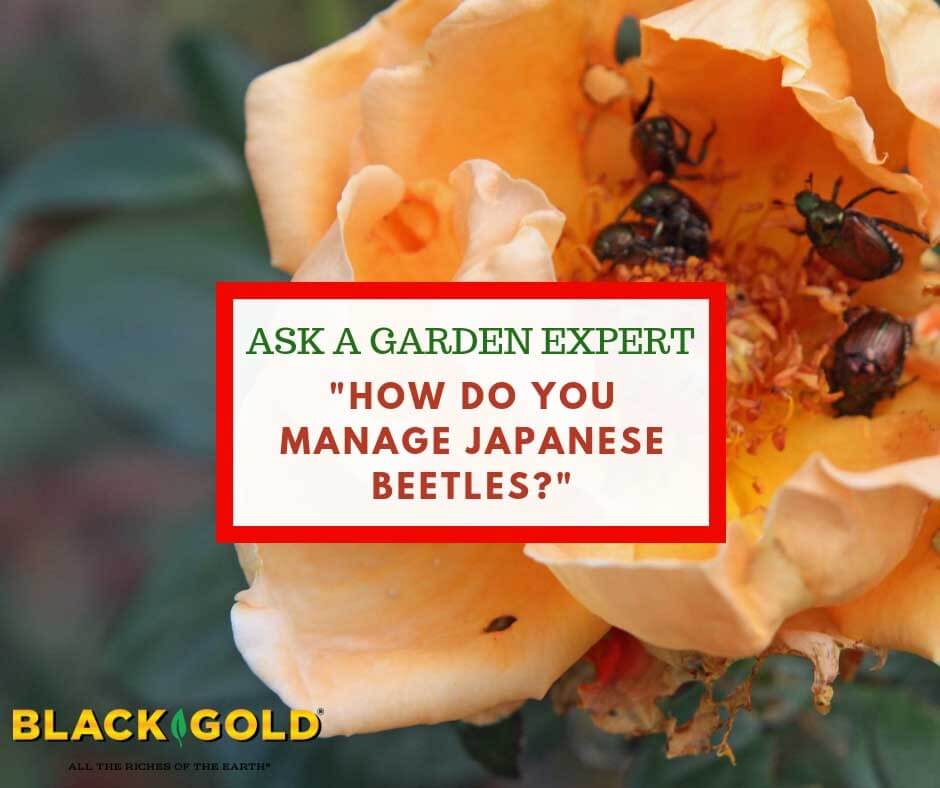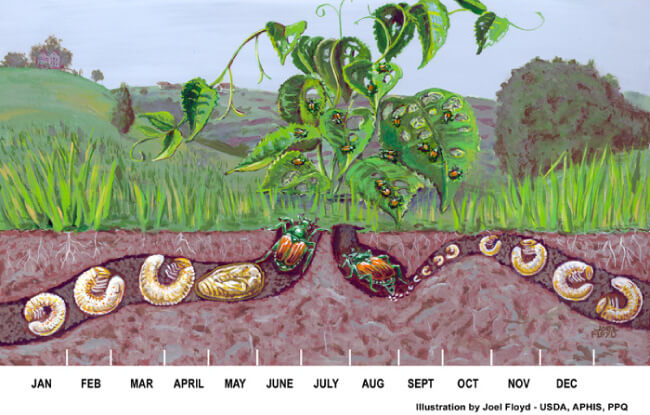 “How do you recommend dealing with Japanese beetles?” Question from Debbie of Lapeer, Michigan
“How do you recommend dealing with Japanese beetles?” Question from Debbie of Lapeer, Michigan
Answer: I know that Japanese beetles (Popillia japonica) are a chronic seasonal problem in Michigan, laying in wait to devastate roses, hibiscus, and many other ornamentals in the summer months. These voracious eaters are known to feed on over 300 plant species. They skeletonize leaves and flowers, weakening plants, and making beautiful specimens look terrible in no time. The key to their management is understanding their life cycle and how to tackle them at different stages of development.
Japanese Beetle Life Cycle
You will begin to see the metallic bronzy green adult beetles from late spring to summer when their underground grubs pupate and emerge to begin their destructive adult period of the cycle. This is when the beetles chomp on leaves and flowers and mate. By midsummer, female beetles will lay between 40 to 60 eggs in the ground. These will hatch into translucent, white, burrowing grubs/larvae that feed on plant roots. Turfgrass roots are a common food source, and the grubs can do significant damage to heavily infested lawns. Larvae develop for around 10 months until the following year when they emerge as adults once again.
Japanese Beetle Management
 Integrated pest management (IPM) guidelines for homeowners set by the USDA’s Agricultural Research Service and Animal and Plant Health Inspection Service (APHIS) are the most proven management methods. They’re backed by years of research, and though there is no perfect Japanese beetle cure for infested areas, these steps will limit their destruction.
Integrated pest management (IPM) guidelines for homeowners set by the USDA’s Agricultural Research Service and Animal and Plant Health Inspection Service (APHIS) are the most proven management methods. They’re backed by years of research, and though there is no perfect Japanese beetle cure for infested areas, these steps will limit their destruction.
Beetle Management
Traps– There are several traps designed to attract and capture Japanese beetles. These generally use sex pheromones or floral lures to draw in the beetles. These are effective, but be careful where you place them. Hang traps away from susceptible flowers and shrubs to help lure them away from (not towards) your garden.
Foliage controls– Use caution when using strong chemical controls for adult beetles because most will kill almost anything they come into contact with, including beneficial bees, butterflies, and ladybugs. Spraying plants with OMRI Listed® neem oil is the recommended solution for organic gardeners. It repels Japanese beetles while not harming birds, pets, people, or beneficial pollinators. Bacillus thuringiensis (Bt) is another organic option that will just harm the grubs and beetles chewing on your beloved plants. New Bt products for adult beetles, such as beetleGONE!®, are very useful.
Manual removal-Adults are slow-moving and easy to catch and drown in jars of water or smash on the ground. If you have a minor infestation, this can be a useful method of removal. Japanese beetles are not a big problem where I live, so this is what I do to control them.
Parasites– There are several commercially available parasitic wasps that will attack Japanese beetles as well as desirable beetle species.
Grub Management
Treating the ground for Japanese Beetle grubs in fall or early to mid-spring will also keep populations in your yard down, though this may not be super helpful if your neighbors don’t treat their lawns, too. The favored organic control is milky spore, a fungal bio-control treatment that will kill underground grubs. grubGone® is Bt from grubs and is also very useful!
 Plant Resistant Plants
Plant Resistant Plants
A final method of control is planting landscape and garden ornamentals that Japanese beetles don’t like. Here are a few flowers they dislike: ageratum, begonia, coreopsis, coral bells, hosta, sedum, nasturtium, poppies, and pansies. Trees and shrubs that Japanese Beetles won’t consume include red maple, boxwood, redbud, holly, dogwood, magnolias, and evergreens. (Amending your soil with Black Gold Garden Soil will help all of these plants perform better in the yard and garden.)
Click here for a complete Japanese Beetle Management Guide!
I hope this helps!
Jessie Keith
Black Gold Horticulturist
